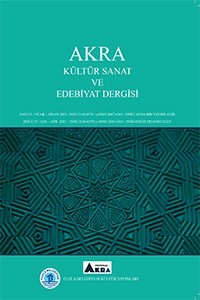DEDE KORKUT HİKÂYELERİ’NDE ANNE ARKETİPİ BAĞLAMINDA OTAĞ SEMBOLÜ
Dede Korkut Hikâyeleri, Türk toplumunun kültürel kodlarını anlatı geleneğine dönüştüren başyapıtlarından biridir. Bu anlatılar, Türk insanının düşünüş ve duyuş tarzını destansı bir anlatımla ebedileştirir. Dede Korkut Hikâyeleri’nde otağ, insan ve mekân ilişkisini ifade eden arketipsel bir semboldür. Ev/otağ, Türk insanının geleneksel inanışlarıyla fiziksel doğumunu ruhsal doğumuyla tamamlayan, otantik gelişimini ve aslî kimliğini yansıttığı özel ve simgesel bir mekândır. Ev/otağ, özel mekânın ve aitliğin simgesel göstergesidir. Kendini ait hissetme olgusunun dönüşüm formudur. Anne arketipi, dişil bir imge olarak; ocak/yuva bağlamıyla aileyi sembolize eder ve yurt arketipiyle de ilişkilidir. Yurt arketipi, aitlik ve ilksel mekân bağlamını taşıyan ezelî bir imgedir. Türk kültüründe ev/yuva ocaktır; ocağın ateşi ve dumanının tütmesi yönüyle ocak, aileye benzetilir. Kırmızı güney yönlüdür ve gücü, kuvveti, ateşi sembolize eder. Sıcak ve canlı olan kırmızı/al renk Dede Korkut Hikâyeleri’nde kadını, gücü, aileyi ifade eder. Dede Korkut Hikâyeleri’nde otağ olgusal mekân bağlamıyla sembolik bir dil koduna dönüşür. Otağ mekânı toplumsal düzenin ve kültürel kimliğin taşıyıcısı olarak olay örgüsünde anlamlar üretir. Türk toplumunun değerleriyle ve gelenekleriyle dizayn edilen otağ/çadır; yuva bağlamıyla yeryüzü ve gökyüzü arasında kendini ifade etmeye çalışan göçebe bir toplumun kültürel mekânını ifade eder. Bu çalışmada Dede Korkut Hikâyeleri’nde otağ/çadır mekânıyla simgeleşen anne arketipi ve yurt imgesi hikâyelerden örneklerle açıklanmıştır. Mekânın geleneksel bir dokuyla aktardığı aile ve ocak ifadeleri özel alan bağlamıyla yorumlanmıştır. Ayrıca hikâyelerden hareketle otağın anlamsal dönüşümlerle kahraman ve kahramanın eylemlerine yön veren sembolik okumaları çözümlenmiştir. Çalışmada edebî eserlerin çözümlenmesinde kullanılan yorum bilim yöntemi kullanılmıştır.
MARQUEE SYMBOL IN THE CONTEXT OF MOTHER ARCHETYPE IN DEDE KORKUT STORIES
Dede Korkut Stories is one of the masterpieces of Turkish society that transform cultural codes into narrative tradition. These narratives eternalize the way of thinking and hearing of the Turkish people with an epic expression. In the Dede Korkut Stories, grass ia an archetypal symbol that expresses the relationship between man and place. The house is a special and symbolic place where the Turkish people reflect their authentic development and essential identity, complementing their physical birth with the spiritual birth. The house is the symbolic sign of private place and belonging. It is the transformation form of the feeling of self-belonging. The mother archetype, as a feminine image; it symbolizes the family in the context of the hearth / nest and is also associated with the marquee archetype. The marquee archetype is a unique image that carries the context of belonging and primeval place. In the Turkish culture, the home / nest is the hearth; hearth is similar to the family in terms of fire and smoke smoking. The red is south oriented and symbolizes power, strength, fire. The warm and lively red / reddish color refers to the woman, power and family in the Dede Korkut Stories. In Dede Korkut Stories, the autonomy becomes a symbolic language code with the context of factual place. Marquee place creates meanings in the plot as a carrier of social order and cultural identity. A marquee / tent designed with the values and traditions of Turkish society; expresses the cultural location of a nomadic society trying to express itself between the nest context and the earth and the sky. In this study, the mother archetype and home image symbolized by the marquee / tent in Dede Korkut Stories were explained with examples from the stories. The family and hearth expressions that the place conveyed with a traditional texture are interpreted in the context of the private sphere. In addition, from the stories, the symbolic readings of the system that direct the actions of the hero and the hero through semantic transformations have been analyzed. In the study, the interpretation science method used in the analysis of literary works was used.
___
- Ergin, Muharrem (1964), Dede Korkut Kitabı, Ankara Üniversitesi Basımevi, Ankara.
- Gökyay, Orhan Şaik (2007), Dedem Korkut’un Kitabı, Akçağ Yayınları, Ankara.
- http://www.turkosfer.com/turklerde-cadirJung,
- C. Gustav (2001), Dört Arketip (Çev. Zehra Aksu Yılmazer), Metis Yayınları İstanbul.
- Kalafat, Yaşar (1995), Doğu Anadolu’da Eski Türk İnancının İzleri, Atatürk Kültür Dil Ve Tarih Yüksek Kurumu Atatürk Kültür Merkezi Yayını, Ankara.
- Kaplan, Mehmet (1999), Türk Edebiyatı Üzerinde Araştırmalar, C.1, Dergah Yayınları, İstanbul.
- Karabaş, Seyfi (1996), Dede Korkut’ta Renkler, Yapı Kredi Yayınları, İstanbul.
- Şenocak, Ebru (2017), İronik Yaşamda Sonsuza Yürüyen Kahraman Nasreddin Hoca, Akçağ Yayınları, Ankara.
- Şimşek, Esma (2003), “Kadirli ve Sumbas (Osmaniye)’ta Evlenme Âdetleri”, Folklor/Edebiyat, IX (34), Ankara.
- Torun, Yeter (2011), Dede Korkut Hikâyelerinde Barınma İle İlgili Sözler ve Bu Sözlerin Birliktelik Kullanımları Üzerine, Turkish Studies - International Periodical For The Languages, Literature And History Of Turkish Or Turkic, Volume 6/3 Summer, P. 1251-1263 Turkey.
- Turner, Victor (2018), Ritüeller/Yapı ve Anti-Yapı (Çev. Nur Küçük), İthaki Yayınları, İstanbul.
